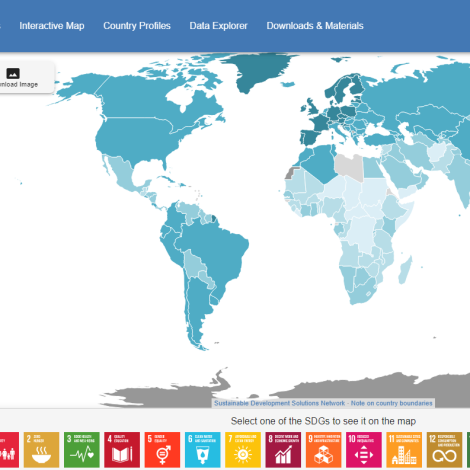The UN’s latest Sustainable Development Goals Report delivers bleak news for meeting the 2030 deadline, pointing to the way forward without pointing fingers at what is to blame. The report lists probable explanations for stagnation and reversals, but it fails to mention key drivers of global poverty, one expert says.
“The report has many lists of things we should do, but not much on why we haven’t done them so far or how to do them. This is disappointing because we already know what we should do. We’re less good on specifying why things are the way they are and what to do about them,” Dr. Erica Schoenberger Professor of Environmental Health and Engineering at The Johns Hopkins University in Baltimore, Maryland (USA) told Engineering for Change.
Where we are
“Half way to 2030, the SDGs are seriously off track – with the poor and highly vulnerable countries suffering the most,” Professor Jeffrey Sachs, President of the Sustainable Development Solutions Network (SDSN) and a lead author of the report, said in a statement.
“It would be unconscionable for the world to miss this opportunity, especially for the richest countries to evade their responsibilities. The SDGs remain fundamental for the future we want,” Dr. Sachs says, referring to upcoming multilateral talks, including the G20 meeting in New Delhi, the SDG Summit New York in September, and COP28 in Dubai.
Disturbingly, less than 20 percent of the SDG targets are on track to be accomplished. The gap is widening in SDG outcomes between high-income countries and low-income countries and is projected to be larger in 2030 than it was in 2015.
Subjective well-being, access to vaccinations, poverty alleviation, and unemployment rates are among the areas that have experienced reversals. Off-track SDGs include those pertaining to hunger, health (SDGs 2 and 3), biodiversity (SDGs 14 and 15), pollution (SDGs 11 and 12), and the establishment of strong institutions and peaceful societies (SDG 16).
It’s not all bad news, however. Since 2015, there has been some headway in enhancing access to infrastructure. SDG 6 (Clean Water and Sanitation), SDG 7 (Affordable and Clean Energy), and SDG 9 (Industry, Innovation, and Infrastructure) have undergone incremental progress.
How we got here
COVID-19 and a confluence of other global crises are the broad causes of the setback, according to the report. Interestingly, a lack of data and data literacy are two of the potential causes of stagnation (and targets for solutions) highlighted. But money draws the most attention. Countries have failed to invest in solutions to meet the goals, the report states.
According to a statement by the Sustainable Development Solutions Network, which published the SDG Report:
“At their core, the SDGs are investment agenda, and the report highlights that the current global financial architecture is failing to channel global savings to SDG investments at the needed pace and scale. In 2023, investment per person in the LICs averaged a meager $175 USD per person, compared with $11,535 USD per person in the HICs (Moody’s and World Bank, 2023). Most LICs and LMICs lack the credit ratings to borrow on acceptable terms… Coupled with these challenges are private capital markets that continue to direct large flows of private savings to unsustainable technologies and practices… The SDR presents a six-point plan to reform the [global financial architecture]…
The attention to funding is sound, says Dr. Schoenberger, but the focus on the global financial architecture may not be very meaningful in the absence of explanations about how it got this way. Could gathering data on big-picture drivers of global poverty lead to practical solutions?
From an email by Dr. Schoenberger:
“They are rightly concerned with funding but talk mainly about what they call the Global Financial Architecture. Okay, but let’s also think about pervasive corruption that drains massive amounts of resources – of genuine wealth – from poor people. This goes on in countries at all levels of development, but it is especially painful to witness the results in the most desperate places.
Let’s also think about multinational corporations that make staggering profits pulling resources out of poor countries while leaving behind environmental messes and while working closely with corrupt governments.
Let’s also think about the global arms trade which drains away a huge amount of money that could be used to address the SDGs. It is also a hotspot of corruption.”
Those are some of the things that help explain why we haven’t achieved the goals. I think it means that the authors need a larger idea of what data needs to be collected. If you collect only the data that relate specifically to the SDGs, you don’t get the whole picture and that means you are reducing your degrees of freedom in thinking about what to do. They want to revamp the international financial order, which is a good idea. I would add, let’s go after bank secrecy laws. Not easy, but easier than restructuring the global financial architecture
The data we do have
Resources
Website: https://www.sdgindex.org/
Data Visualization: https://dashboards.sdgindex.org/
New SDG Transformation Center: https://sdgtransformationcenter.org/
The SDG Transformation Center provides a suite of science-based instruments serving as a platform for peer to-peer learning and exchange among scientists, practitioners, and investors on the next generation of SDG policy tools, analytics, and long-term pathways, according to a statement on the SDG Index. Building on an innovative partnership between the SDSN and the Environmental Systems Research Institute (Esri), this year’s SDG Index incorporates two new indicators that build on geospatial tools to measure access to key urban services and access to roads.

